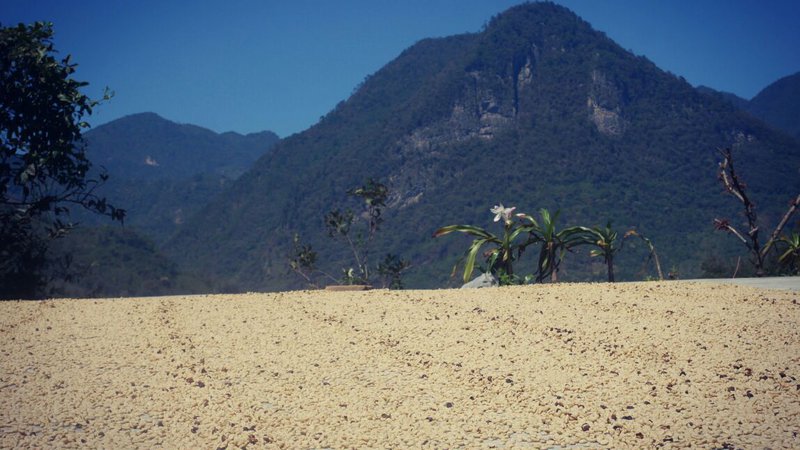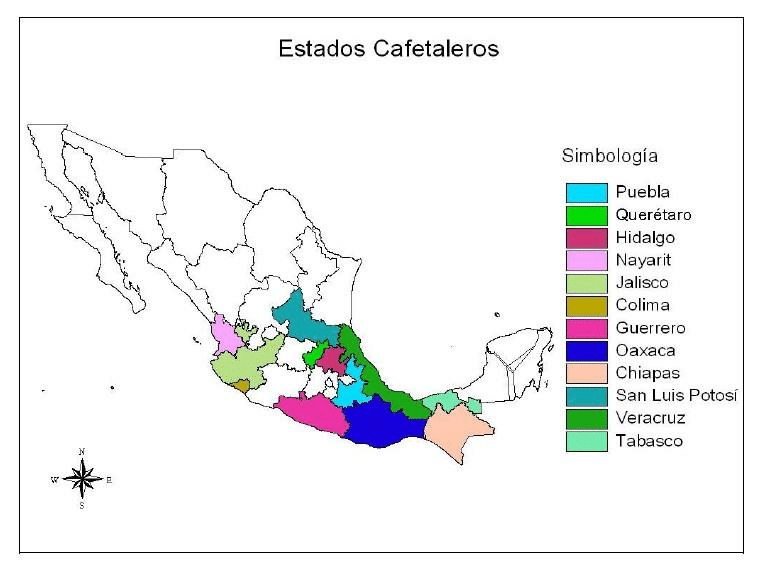Coffee in Mexico

CONTEXT
The coffee mainly grows on the slopes of the central and southern mountains under the canopy. There are 15 producing States, with Chiapas in the south of the country, being the main producer with 41.0% of the national volume, followed by Veracruz (24.0%) and Puebla (15.3%).
Coffee production employs over 500,000 producers from 480 municipalities. For the period 2018-2019, it is estimated that the production volume will be 4 million bags, 5.8% more than the previous year. The objective is to increase the coffee sector's productivity to 4.5 million bags (60 kg) and to achieve a sustainable harvest of 15 million bags by 2030.
Mexico is also one of the world's leader for the production of organic coffee. It allocates 3.24% of the total cultivated area and exports 28 000 tonnes. In the last decade, production and prices have declined considerably mainly because of the coffee leaf rust that attacks the leaves and make them fall. Defoliation prevents photosynthesis necessary for the life of the tree and the production of fruit. Following the epidemic that hit the country between 2012 and 2014, Mexico lost five places on the world list of coffee producing countries.
Nonetheless, the coffee leaf rust is not the only or the main problem for coffee production. The plants are also too old, over 20 or 30 and need to be rejuvenated. But investment is minimal, especially in poor and remoted villages where there is little access to technology and where old and unefficient farming methods still apply.
Since 2015, the level of production has increased again after seeding new hybrids of arabica and some robusta, both more resistant to diseases and climate change than traditional varieties.
In 2016, 56.3% of the national production was of arabica type against 43.7% of robusta. Since then, the country has tripled the robusta coffee production from 200,000 to 750,000 60 kilo bags for the 2017-2018 harvest and has become the same time a net importer. From 1992 to 2016, the country increased its imports of robusta by 10 to produce soluble coffee which still represents the highest consumption. Currently each inhabitant consumes on average 1.4 kg of coffee (ground or soluble) per year, which is still pretty low compared to the 12kg per capita per year in Scandinavian countries.
More than 280,000 producers participate in coffee production. They are mainly smallholders and indigenous peoples living in marginalized areas, grouped together in different local and regional organizations. In Mexico, 85% of coffee growers are smallholders because they have no more than two hectares to cultivate. They belong to 25 different ethnic groups in 480 municipalities in 15 central and southern States.
COFFEE REGIONS

In Mexico, there are 15 coffee producing states. Chiapas is the main producing state with 41.0% of the national volume, followed by Veracruz (24.0%) and Puebla (15.3%).
A BIT OF HISTORY
The coffee of the Antilles that arrived in Mexico in 1790 would have entered directly through the port of Veracruz. There it began to be commercially produced and exported for the first time in 1802. Juan Antonio Gómez is the responsible for the intensification of culture in that State in 1817. In 1826 there were half a million plants. Then in 1846, coffee trees were imported from San Pablo (Guatemala) to the region of Soconusco (Chiapas).
The third source of diffusion was finally found in 1828 in Uruapan (Michoacán) with plants apparently brought from Moca (Yemen). There is no doubt that the culture spread during the first half of the nineteenth century, mainly to Veracruz, Chiapas, Tabasco and Michoacan.
In the early 20th century, domestic coffee production was affected by the Mexican revolution of 1910, which led to a collapse of production due to the abandonment of plantations. Subsequently, production improved in the 1930s.This critical fall down led the authorities to devise policies to improve coffee production and in 1958, was created the Mexican Institute of Coffee (INMECAFE) with the main objective of promoting and disseminating more adequate systems of cultivation, processing and industrialization.
With the dissolution of the Mexican Coffee Institute in 1989, the price of coffee became subject to the free market. However, the federal government did not create the bodies that, in the absence of the institute, would keep protecting the sector. The suspension of the quota system has caused serious liquidity problems for exporters as, at the time where prices where falling, their warehouses were full. When they were forced to sell green coffee at prices that were 30-40% lower, many of the mills' owners were left without capital and had no options but to close down.
The mills were abandoned, the farms were sold and many producers or industry players went to the United States to work and get better incomes. Some came back a few years later, others stayed away from their families and from the coffee tradition.
The same story is repeated and today young people keeps going away from their home coffeland looking for a better future.
VARIETALS
Among the main cultivated varieties of Coffea arabica in Mexico, we can find:
- Typica or criollo;
- Caribbean Bourbon;
- Maragogype, which has one of the largest grains in the world that comes from a mutation of Typica discovered in Brazil in 1870;
- Caturra, an evolution of Bourbon;
- Pluma Hidalgo, a tropicalization of typica cultivated in the mountainous areas of Oaxaca;
- Garnica, a variety developed in Veracruz from the crossing of Mundo Novo and Caturra;
- Garien, a variety from a spontaneous mutation of a small garnica;
- Catimores (hybrids of Caturra + Hybrid of Timor) that can offer a good quality in the cup with a certain resistance to the leaf rust.
Varieties such as Oro Azteca, Costa Rica, Castillo (Colombia), Marsellesa, among others, represent today an important part of the Mexican coffee park.
PERSPECTIVES FOR THE MEXICAN COFFEE SECTOR
"Coffee can not evolve solely from a business perspective, it must take a step towards humanity."
One can observe a clear new approach to quality with the implementation of new processing methods and good harvest and post-harvest practices to reach the specialty market. The resilience of some producers is also noteworthy. With the support of various types of organizations (cooperatives, companies), they indeed try to conserve traditional varieties and to improve farming practices to reach a better quality and productivity.
(Some examples of organizations of this type: Femcafé, Yomolatel, Capeltic, Caravela Coffee, Cafeologo.)
These new organizations also bring a gender perspective, aspects of social and food justice and human rights.
REFERENCES
- www.directoalpaladar.com.mx/ingredientes-y-alimentos/cuales-diferentes-tipos-cafe-que-se-cultivan-mexico
- www.amcce.org.mx/letras-de-cafe/post/la-historia-del-cafe-en-mexico
- www.jornada.com.mx/ultimas/2018/11/10/variedad-robusta-de-cafe-invade-a-mexico-alertan-6199.htmlhttps://heraldodemexico.com.mx/mer-k-2/mexico-potencia-en-produccion-de-cafe-a-nivel-mundial/
- vanguardia.com.mx/articulo/cafe-mexicano-con-aroma-crisis
- Extract from the interview of Manuél Garcia Estrada - director of the Academy of Arts & Sciences of Coffee and Manager of the Rococo Café Espresso - disponible sur notre chaîne YouTube

 Colombia
Colombia Ethiopia
Ethiopia Guatemala
Guatemala Indonesia
Indonesia Kenya
Kenya Mexico
Mexico Philippines
Philippines Tanzania
Tanzania Uganda
Uganda